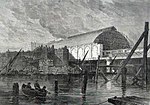Toole's Theatre

Toole's Theatre, was a 19th-century West End building in William IV Street, near Charing Cross, in the City of Westminster. A succession of auditoria had occupied the site since 1832, serving a variety of functions, including religious and leisure activities. The theatre at its largest, after reconstruction in 1881–82, had a capacity of between 650 and 700. As the Charing Cross Theatre (1869–1876) the house became known for bills offering a mixture of drama, burlesque and operetta. Among the authors of its burlesques were W. S. Gilbert and H. B. Farnie. Its stars included Lydia Thompson, Lionel Brough and Willie Edouin. In 1876 Thompson and her husband, Alexander Henderson, became lessees of the theatre and renamed it the Folly Theatre. They continued the theatre's customary mix of operetta and burlesque. Their greatest successes were with English adaptations of French opéras bouffes and opéras comiques, most conspicuously Les cloches de Corneville, which began its record-breaking run (705 performances) at the Folly in 1878. In 1879 the comic actor J. L. Toole took over the lease. In 1881 he changed the name to Toole's Theatre and had the building substantially reconstructed. He continued the policy of staging burlesques, but introduced more non-musical comedies and farces. Among the authors who wrote for the theatre were John Maddison Morton, F. C. Burnand and Henry Pottinger Stephens; composers included George Grossmith and Edward Solomon. The theatre was important for beginning the professional careers of many actors, writers and actor-managers. Among the playwrights whose early works were presented at Toole's were Arthur Wing Pinero and J. M. Barrie. Future stars who were members of the company as beginners included Kate Cutler, Florence Farr, Seymour Hicks, Irene and Violet Vanbrugh and Lewis Waller. The lease of the theatre expired in 1895, and the lessor, the Charing Cross Hospital, did not renew it. The theatre was demolished in 1896.
Excerpt from the Wikipedia article Toole's Theatre (License: CC BY-SA 3.0, Authors, Images).Toole's Theatre
Northumberland Street, City of Westminster Covent Garden
Geographical coordinates (GPS) Address Nearby Places Show on map
Geographical coordinates (GPS)
| Latitude | Longitude |
|---|---|
| N 51.507466 ° | E -0.122981 ° |
Address
Charing Cross Railway Station
Northumberland Street
WC2N 5DA City of Westminster, Covent Garden
England, United Kingdom
Open on Google Maps








